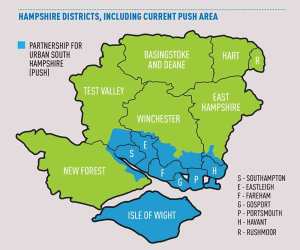 Ever since the Greater Manchester Combined Authority was formed in 2011, local councils have been asking themselves whether they should follow suit. What really made them sit up and take note, though, was when, last November, Greater Manchester agreed a historic deal with central government that devolved powers and responsibilities to the North West.
Ever since the Greater Manchester Combined Authority was formed in 2011, local councils have been asking themselves whether they should follow suit. What really made them sit up and take note, though, was when, last November, Greater Manchester agreed a historic deal with central government that devolved powers and responsibilities to the North West.
Only a month later, leaders of some Hampshire councils, together with the Solent local enterprise partnership, wrote to government minister Greg Clark, expressing an interest in forming a Solent area combined authority. Since then there has been considerable internal debate about what benefits a combined authority might bring, how it would operate, and, crucially, what geographic area it would cover.
The main drivers are the councils that are members of the 13-year-old Partnership for Urban South Hampshire (PUSH), so a combined authority covering this area would seem logical. However, the PUSH area includes only part of some districts (see map) and, under current legislation, part-districts cannot be included in a combined authority. This is particularly relevant for Winchester (pictured), only the southern part of which is within PUSH. Séan Woodward, chair of PUSH and executive leader of Fareham borough council, says they are still awaiting a response from government on the issue of part-districts, so no decision will be made until this has been clarified.
 An alternative solution, apparently favoured by Hampshire county council, is a county-wide combined authority. If this option were chosen, it could even extend across the county boundary – for example, to include Chichester in neighbouring West Sussex. Gary Jeffries, chair of Solent LEP and managing director of South Coast agency Hughes Ellard, is open to both options: “The LEP is not fixed on boundaries – we can see the benefits in both and are happy to work with either. Getting local authorities working more closely on economic regeneration and spatial strategy is a good thing for property markets generally.”
An alternative solution, apparently favoured by Hampshire county council, is a county-wide combined authority. If this option were chosen, it could even extend across the county boundary – for example, to include Chichester in neighbouring West Sussex. Gary Jeffries, chair of Solent LEP and managing director of South Coast agency Hughes Ellard, is open to both options: “The LEP is not fixed on boundaries – we can see the benefits in both and are happy to work with either. Getting local authorities working more closely on economic regeneration and spatial strategy is a good thing for property markets generally.”
While the merits of a combined authority are still being mulled over by council leaders in Hampshire, many industry experts are already convinced. John Adams, head of planning at Deloitte Real Estate, says that one of the key wins of a tie-up is the ability to share (planning) officer experience and specialist knowledge and to create larger and deeper teams to handle big projects. “I see significant benefits with this,” he says. “Within the PUSH area they have been effectively campaigning for large-scale housing for over 10 years, so combining should be a very logical next step.”
One downside of a combined authority, however, is that it might be tempted to recreate planning policy. “Our biggest fear would be if it created a new set of local plans,” admits Adams. “In the Solent area the big priority is to move towards delivery of big housing and infrastructure projects, so the focus should be on increasing delivery capability to allow development on the ground to be successfully implemented.”
Another potential issue for a combined authority is whether the constituent councils can recruit staff at a time when there are skills shortages across a wide range of functions. “The Solent area has a problem of people being sucked towards London,” reports Kevin Redman, director of the Property Recruitment Company. “Local authorities have been very skinny – and now the eyes of the world are turning on them, their biggest problem could be a lack of sufficient resources, as many made a lot of cuts after the global economic crash and haven’t really recovered since.”
However, the formation of a combined authority in Hampshire is by no means a foregone conclusion. PUSH’s Woodward says that it hasn’t formulated a definitive view yet and is waiting for further information from the government. “We’re not ruling anything out, but we’re certainly not looking at a combined authority at any cost,” he states.
Donna Jones, leader of Portsmouth city council, is more unequivocal: “We believe a combined authority focused on very specific targets could work,” she says, although she is adamant that a county-wide model is not suitable.
Jones was one of several council leaders who met last month for a summit on devolution and combined authorities, and clearly there remains much more to discuss, including how the process will proceed. While the leaders’ summit concluded that the onus was on them to develop options, Jones maintains: “The ball is in the government’s court – it will be for the new government to take forward.”
A rather short and bland statement issued after the summit nevertheless indicates the key areas a Solent combined authority would focus on: skills, transport and economic development. These are more modest devolution goals than in Manchester, but as the PUSH area is around half the size of Greater Manchester (1.3m people, compared with 2.7m) it may be sensible not to take on more ambitious powers such as control of NHS services.
With much still to be decided locally – and the uncertainty of general and local elections added to the mix – it is unclear when, if it all, a combined authority might start work. Those involved suggest it could be up to a year away. Solent LEP’s Jeffries comments: “It’s potentially a slow burn – these things don’t happen overnight. However, the mood about devolution generally is to explore quickly and no one has an appetite to talk for a long time.”
Green light in Brighton
 Brighton and Hove, which was made a city in the millennium celebrations, has always had something of a renegade status. And since 2010 it has been unique in having a both a Green Party-led council and a Green MP, Caroline Lucas. The bets are off as to how the voting will go in just over a month – but should the ballot box result in another period of Green party control, local property folk appear pretty sanguine about it.
Brighton and Hove, which was made a city in the millennium celebrations, has always had something of a renegade status. And since 2010 it has been unique in having a both a Green Party-led council and a Green MP, Caroline Lucas. The bets are off as to how the voting will go in just over a month – but should the ballot box result in another period of Green party control, local property folk appear pretty sanguine about it.
True, there have been some spats, gleefully picked up by the local media, such as a run-in with binmen in summer 2013 that left rubbish rotting in the streets, and a more recent climb-down on “Meat-free Mondays” in council canteens, owing to protests from some employees (allegedly the bin men). But from a property perspective the Greens seem to have done little to raise the ire of stalwarts such as Cluttons partner Bill Shipley. “They haven’t had a particularly negative impact on the property market,” he confirms. “From a general property perspective the city continues to do very well: the number of vacant units is low and projects such as the Brighton Road Regeneration Scheme are continuing.”
 In fact, in a surprising turn of events, criticism of the Greens, and of council leader Jason Kitcat, who is standing down at the forthcoming elections, has focused on their pro-development stance for a £46m project that could invigorate the seafront around the West Pier. Last year Green councillors formed an unlikely alliance with their Conservative counterparts to grant planning consent for i360, a 530ft observation tower that is a curious cross between the London Eye (it was created by the same architects) and Portsmouth’s Spinnaker tower. A circular pod holding up to 200 people will climb, like a vertical cable car, to 450ft. Construction of the main tower is due to start this summer, with completion scheduled for next year.
In fact, in a surprising turn of events, criticism of the Greens, and of council leader Jason Kitcat, who is standing down at the forthcoming elections, has focused on their pro-development stance for a £46m project that could invigorate the seafront around the West Pier. Last year Green councillors formed an unlikely alliance with their Conservative counterparts to grant planning consent for i360, a 530ft observation tower that is a curious cross between the London Eye (it was created by the same architects) and Portsmouth’s Spinnaker tower. A circular pod holding up to 200 people will climb, like a vertical cable car, to 450ft. Construction of the main tower is due to start this summer, with completion scheduled for next year.
Opponents of the futuristic steel-and-glass erection complain that it is out of place on Brighton’s low-rise sea front, but Cluttons’ Shipley isn’t one of them. “The net result will be a regeneration of the seafront,” he says, “and that can only be a good thing.”











